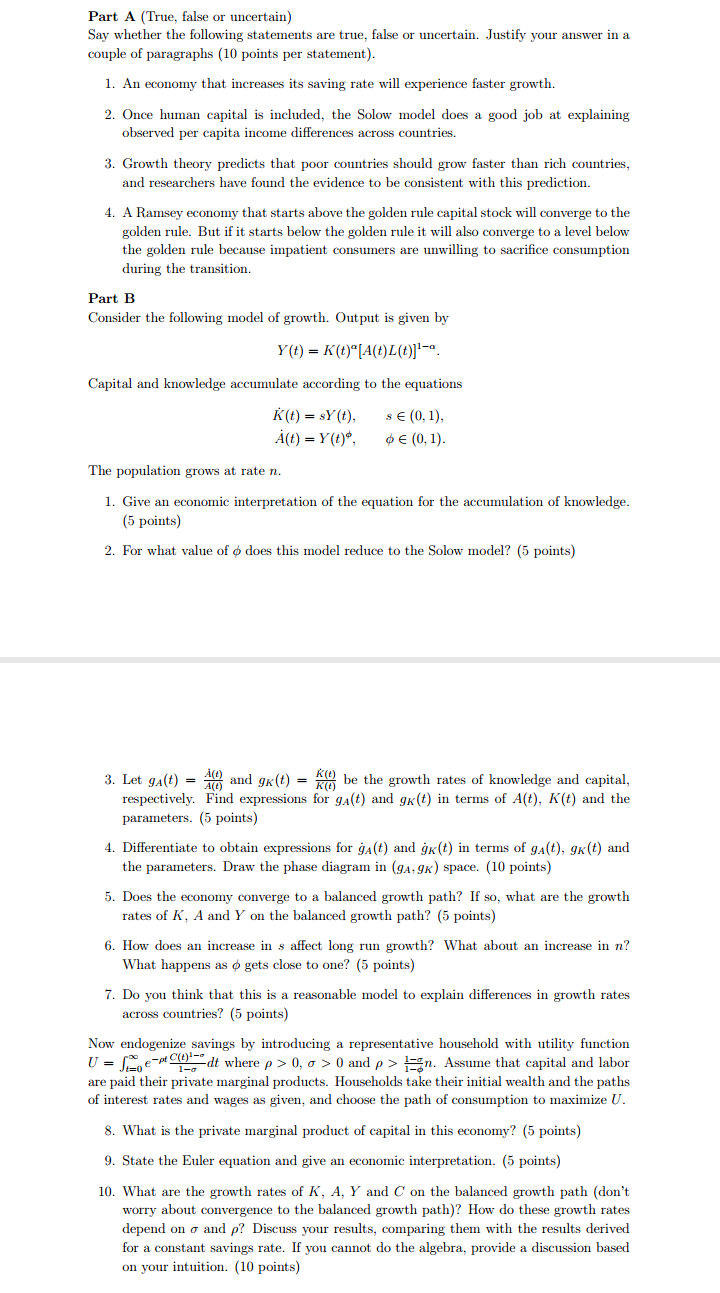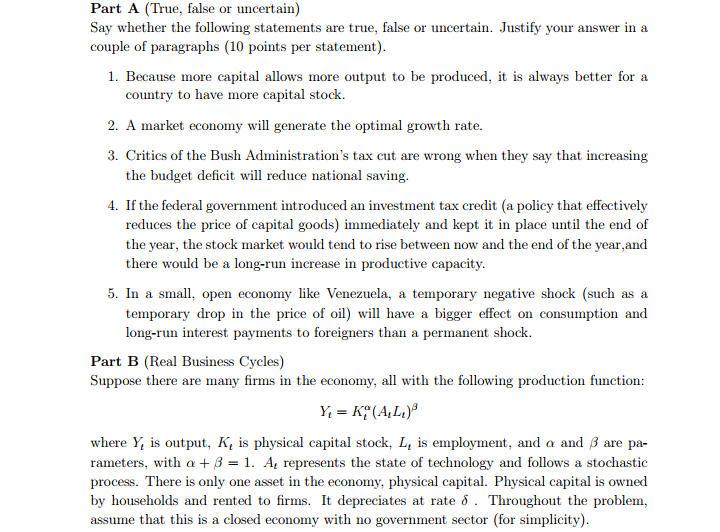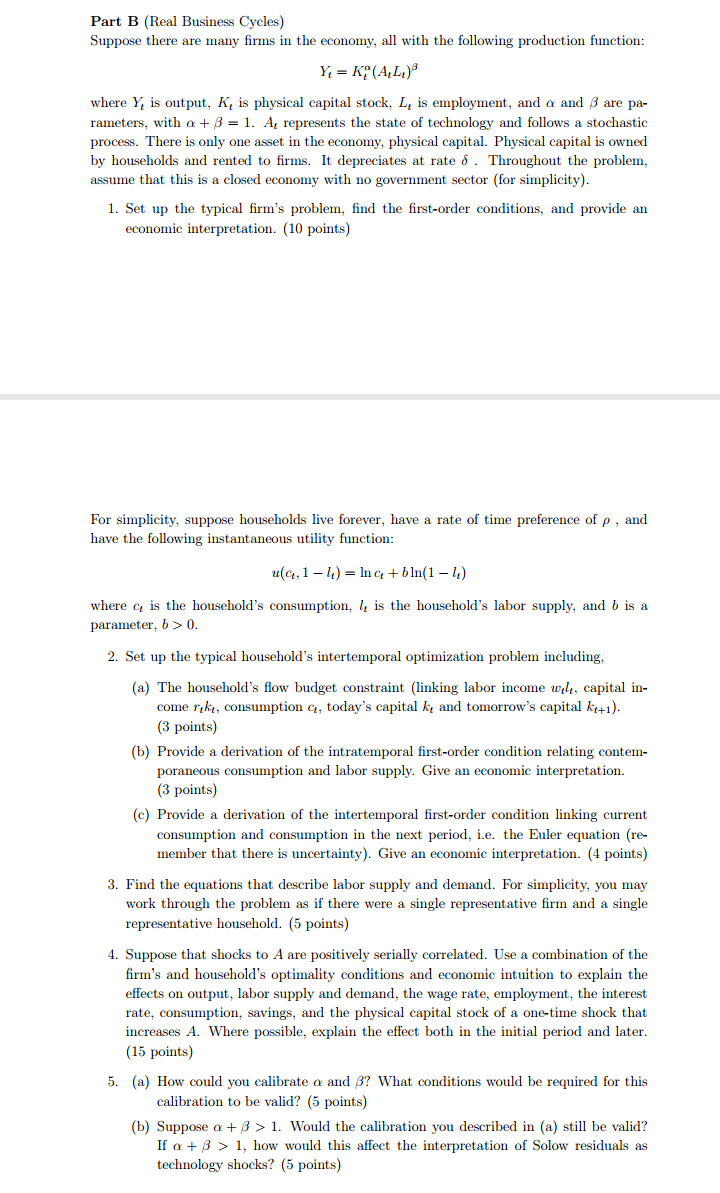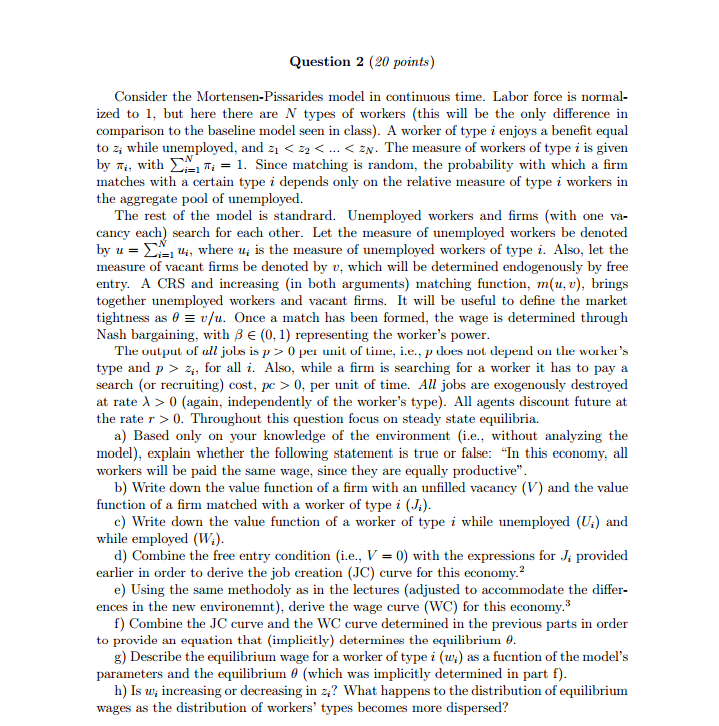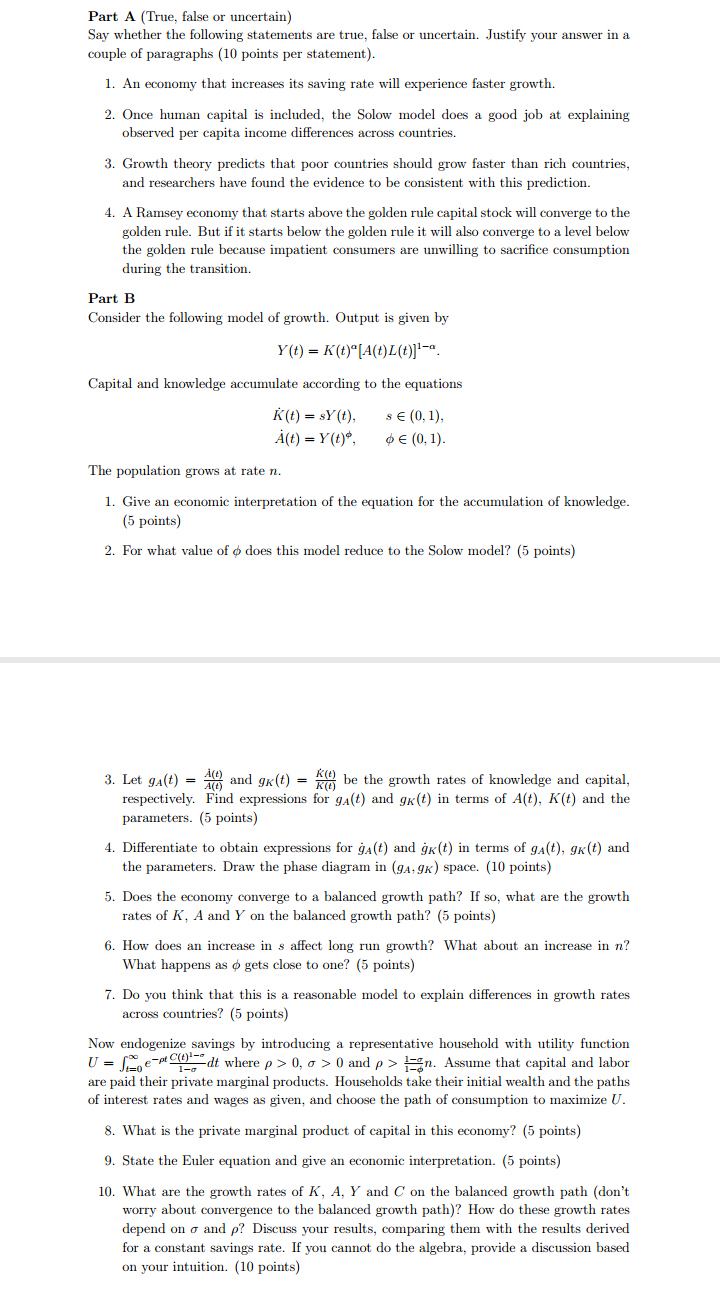
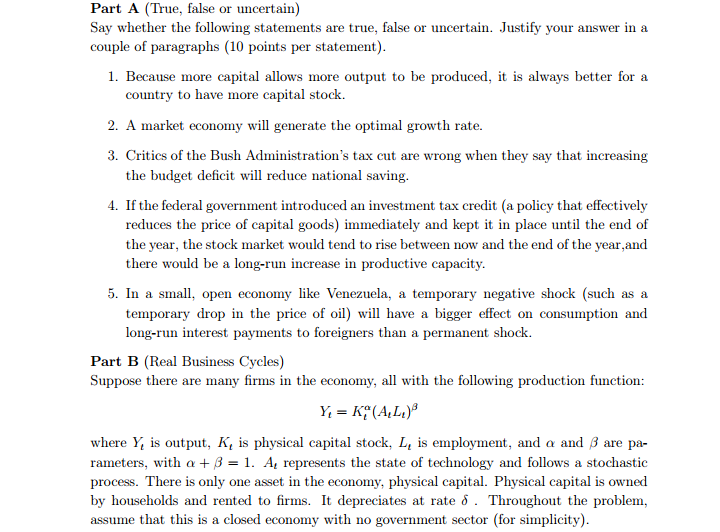
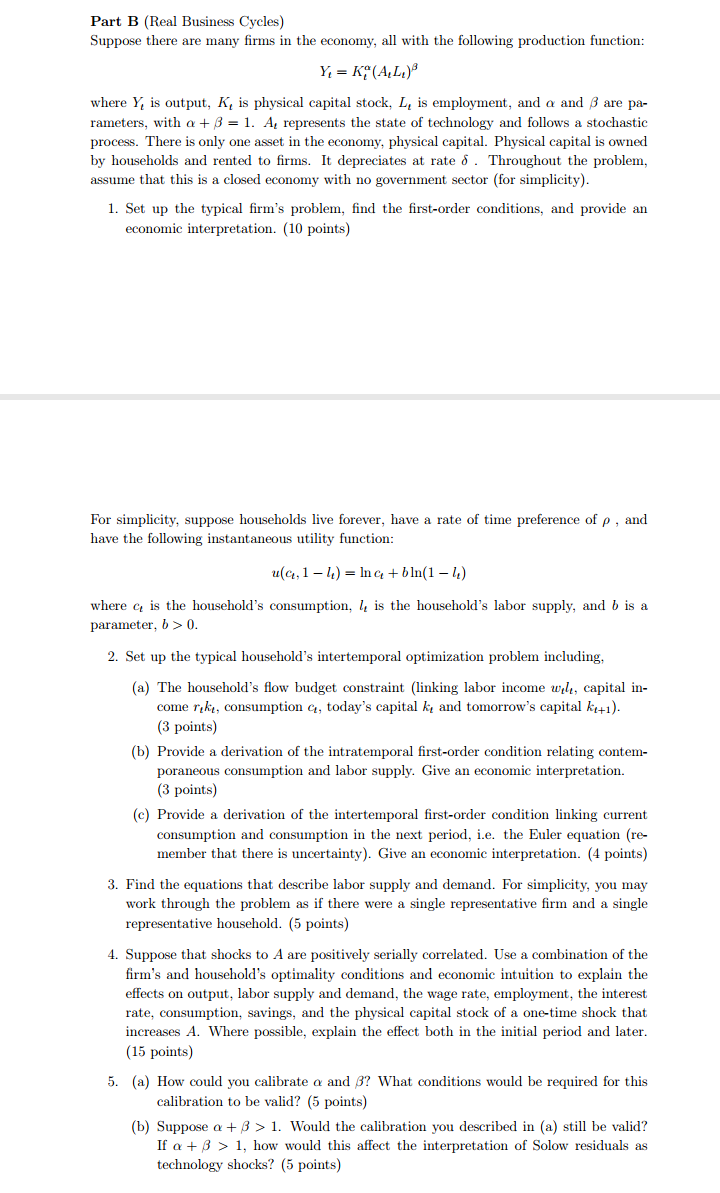
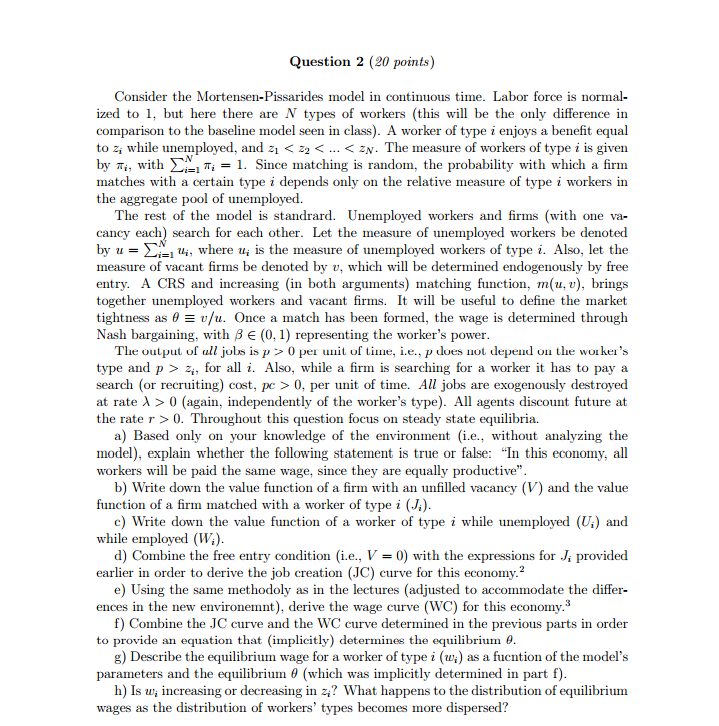
The answer shd be well explained
Part. A (The, false or uncertain] Say whether the following statements are true, false or uncertain. Justify your answer in a couple of paragraphs [l points per statement}. 1. An economy that increases its saving rate will experience faster growth. 2. Once human capital is included, the Solow model does a good job at explaining observed per capita income differences across countries. 3. Growth theory predicts that poor countries should grow faster than rich countries, and researchers have found the evidence to be consistent with this prediction. 4. A Ramsey economy that starts above the golden rule capital stock will converge to the golden rule. But ifit starts below the golden rule it will also converge to a level below the golden role because impatient consumers are unwilling to sacrice consumption during the transition. Part B Consider the following model of growth. Output is given by on = mammal\". Capital and lmowledge accumulate according to the equations fft]=sl'{:, sewn}, AItJ=YW= vein. 1)- The population grows at rate it. 1. Give an economic interpretation of the equation for the accumulation of knowledge. (5 points] 2. For what value of a does this model reduce to the Solow model? (5 points} 3. Let 9,402} = % and gm) = % be the growth rates of knowledge and capital, respectively. Find expressions for 9,13) and gx} in terms of Am, Km and the parameters. (5 points] 4. Differentiate to obtain expressions for gut} and 93(3) in terms of Su}, gym and the parameters. Draw the phase diagram in (gmgg) space. [l points] 5. Does the economy converge to a balanced growth path? If so, what are the growth rates of K, A and Y on the balanced growth path? (5 points] 6. How does an increase in s aEect long run growth? What about an increase in 11? What happens as it: gets close to one? (5 points} 7. Do you thin]: that this is a reasonable model to ear-plain differences in growth rates across countries? {5 points} Now endogenize savings by introducing a representative household with utility function U = fag-#Cil';wdt where p :5 c, or > :1 and p } n. Assume that capital and labor are paid their private marginal products. Households talre their initial wealth and the paths of interest rates and wages as given1 and choose the path of consumption to maximize U. 8. What is the private marginal product of capital in this economy? {5 points] 9. State the Euler equation and give an economic interpretation. (5 points} 10. What are the growth rates of K, A, l" and C on the balanced growth path (don't irony about convergence to the balanced growth path}? How do these growth rates depend on o and ,9? Discuss your results, comparing them with the results derived for a constant savings rate. If you cannot do the algebra, provide a discussion based on your intuition. (10 points] Part A (True, false or uncertain] Say whether the following statements are true, false or uncertain. Justify your answer in a couple of paragraphs [ll] points per statement}. 1. Because more capital allows more output to be produced, it is always better for a country to have more capital stoclr. 2. A. market economy will generate the optimal growth rate. 3. Critics of the Bush Administrations tax cut are wrong when they say that increasing the budget decit will reduce- national saving. 4. If the federal government introduced an investment tax credit [a policy that effectively reduces the price of capital goods} immediately and kept it in place until the end of the year, the stock market would tend to rise between now and the end of the year,and there would be a long-run increase in productive capacity. 5. In a small, open economy like 1|v'enezuela, a temporary negative shock [such as a temporary drop in the price of oil] will have a bigger effect on consumption and long-run interat payments to foreigners than a permanent shock. Part B [Real Business Ewes} Suppose there are many rms in the economy, all with the following production function: E = Kf'{A.L.}3 where Y, is output, K, is physical capital stock, L, is employment, and or and ii are pa- rameters, with o: + ,5 = 1. A. represents the state of technology and follows a stochastic procem. There is only one amet in the economy, physical capital. Physical capital is owned by households and rented to firms. It depreciates at rate 5 . Throughout the problem, assume that this is a closed economy with no government sector (for simplicity}. Part B {Real Business Cycles) Suppose there are many rms in the economy, all with the following production function: Y. = Efren? where Y, is output, K, is physical capital stock, L, is employment, and or and d are pa- rameters, with o: + ,3 = 1. A. represents the state of technology and follows a stochastic procem. There is only one met in the economy, physical capital. Physical capital is owned by households and rented to rms. It depreciates at rate d . Throughout the problem, assume that this is a closed economy with no government sector (for simplicity}. 1. Set up the typical rm's problem, find the first-order conditions, and provide an economic interpretation. [10 poinm} For simplicity, suppose households live forever, have a rate of time preference of p , and have the following instantaneous utility function: u[c,_,] E,] = lnc, +oln(l l.) where c, is the household's consumption, l. is the household's labor supply, and b is a parameter, b 3- (l. 2. Set up the typical household's intertemporal optimization problem including, (a) The household's ow budget constraint [linking labor income 1nd,, capital in- come rlkl, consumption .21, today's capital It. and tomorrow's capital In\"). (3 points} (b) Provide a. derivation of the intratemporal rst-order condition relating contem- poraneous consumption and labor supply. Give an economic interpretation. (3 points} (c) Provide a derivation of the intertemporal rst-order condition linking current consumption and consumption in the next period, is. the Euler equation {re- member that there is uncertainty]. Give an economic interpretation. (4 points} 3. Find the equations that describe labor supply and demand. For simplicity, you may work through the problem as it" there were a single representative rm and a single representative household. (5 points] 4. Suppose that shocks to A are positively serially correlated. Use a combination of the rm's and household's optimality conditions and economic intuition to explain the e'ects on output, labor supply and demand, the wage rate, employment, the interest rate, consumption, savings, and the physical capital stock of a one-time shock that increases A. Where possible, explain the effect both in the initial period and later. {15 points) 5. [a] How could you calibrate c: and 3? What conditions would be required for this calibration to be valid? (5 points) (b) Suppose G: + ,3 > 1. Would the calibration you described in {a} still be valid? It" or + ,8 3: 1, how would this a'ect the interpretation of Solow residuals as technologr shocks? {5 points} Question 2 (20 points) Consider the Mortensen-Pissarides model in continuous time. Labor force is normal- ized to 1, but here there are N types of workers (this will be the only difference in comparison to the baseline model seen in class). A worker of type i enjoys a benefit equal to z while unemployed, and z1 2, for all i. Also, while a firm is searching for a worker it has to pay a search (or recruiting) cost, pc > 0, per unit of time. All jobs are exogenously destroyed at rate > > 0 (again, independently of the worker's type). All agents discount future at the rate r > 0. Throughout this question focus on steady state equilibria. a) Based only on your knowledge of the environment (i.e., without analyzing the model), explain whether the following statement is true or false: "In this economy, all workers will be paid the same wage, since they are equally productive". b) Write down the value function of a firm with an unfilled vacancy (V) and the value function of a firm matched with a worker of type i (J;). c) Write down the value function of a worker of type i while unemployed (U.) and while employed (W.). d) Combine the free entry condition (i.e., V = 0) with the expressions for J; provided earlier in order to derive the job creation (JC) curve for this economy. e) Using the same methodoly as in the lectures (adjusted to accommodate the differ- ences in the new environemnt), derive the wage curve (WC) for this economy." f) Combine the JC curve and the WC curve determined in the previous parts in order to provide an equation that (implicitly) determines the equilibrium 0. g) Describe the equilibrium wage for a worker of type i (wy) as a fuction of the model's parameters and the equilibrium # (which was implicitly determined in part f). h) Is w; increasing or decreasing in ? What happens to the distribution of equilibrium wages as the distribution of workers' types becomes more dispersed




